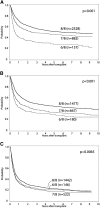Nonpermissive HLA-DPB1 mismatch increases mortality after myeloablative unrelated allogeneic hematopoietic cell transplantation
- PMID: 25161269
- PMCID: PMC4199961
- DOI: 10.1182/blood-2014-05-576041
Nonpermissive HLA-DPB1 mismatch increases mortality after myeloablative unrelated allogeneic hematopoietic cell transplantation
Abstract
We examined current outcomes of unrelated donor allogeneic hematopoietic cell transplantation (HCT) to determine the clinical implications of donor-recipient HLA matching. Adult and pediatric patients who had first undergone myeloablative-unrelated bone marrow or peripheral blood HCT for acute myelogenous leukemia, acute lymphoblastic leukemia, chronic myelogenous leukemia, and myelodysplastic syndrome between 1999 and 2011 were included. All had high-resolution typing for HLA-A, -B, -C, and -DRB1. Of the total (n = 8003), cases were 8/8 (n = 5449), 7/8 (n = 2071), or 6/8 (n = 483) matched. HLA mismatch (6-7/8) conferred significantly increased risk for grades II to IV and III to IV acute graft vs host disease (GVHD), chronic GVHD, transplant-related mortality (TRM), and overall mortality compared with HLA-matched cases (8/8). Type (allele/antigen) and locus (HLA-A, -B, -C, and -DRB1) of mismatch were not associated with overall mortality. Among 8/8 matched cases, HLA-DPB1 and -DQB1 mismatch resulted in increased acute GVHD, and HLA-DPB1 mismatch had decreased relapse. Nonpermissive HLA-DPB1 allele mismatch was associated with higher TRM compared with permissive HLA-DPB1 mismatch or HLA-DPB1 match and increased overall mortality compared with permissive HLA-DPB1 mismatch in 8/8 (and 10/10) matched cases. Full matching at HLA-A, -B, -C, and -DRB1 is required for optimal unrelated donor HCT survival, and avoidance of nonpermissive HLA-DPB1 mismatches in otherwise HLA-matched pairs is indicated.
© 2014 by The American Society of Hematology.
Figures
Comment in
-
HLA-DP1 matching: are we there yet?Blood. 2014 Oct 16;124(16):2476-7. doi: 10.1182/blood-2014-09-599225. Blood. 2014. PMID: 25323686
References
-
- Flomenberg N, Baxter-Lowe LA, Confer D, et al. Impact of HLA class I and class II high-resolution matching on outcomes of unrelated donor bone marrow transplantation: HLA-C mismatching is associated with a strong adverse effect on transplantation outcome. Blood. 2004;104(7):1923–1930. - PubMed
-
- Fürst D, Müller C, Vucinic V, et al. High-resolution HLA matching in hematopoietic stem cell transplantation: a retrospective collaborative analysis. Blood. 2013;122(18):3220–3229. - PubMed
-
- Lee SJ, Klein J, Haagenson M, et al. High-resolution donor-recipient HLA matching contributes to the success of unrelated donor marrow transplantation. Blood. 2007;110(13):4576–4583. - PubMed
-
- Morishima Y, Sasazuki T, Inoko H, et al. The clinical significance of human leukocyte antigen (HLA) allele compatibility in patients receiving a marrow transplant from serologically HLA-A, HLA-B, and HLA-DR matched unrelated donors. Blood. 2002;99(11):4200–4206. - PubMed
-
- Petersdorf EW, Longton GM, Anasetti C, et al. Association of HLA-C disparity with graft failure after marrow transplantation from unrelated donors. Blood. 1997;89(5):1818–1823. - PubMed
Publication types
MeSH terms
Substances
Grants and funding
LinkOut - more resources
Full Text Sources
Other Literature Sources
Medical
Research Materials



